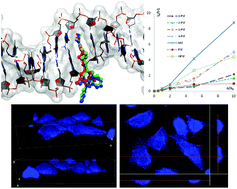Copper(i) complexes with phosphine derived from sparfloxacin. Part II: a first insight into the cytotoxic action mode†
Abstract
In this paper we present a first insight into the cytotoxic action mode of copper(I) iodide or copper(I) thiocyanate complexes with a phosphine derivative of sparfloxacin (a 3rd generation fluoroquinolone antibiotic agent) and 2,9-dimethyl-1,10-phenanthroline or 2,2′-biquinoline as auxiliary ligands. The in vitro cytotoxic activity of the new complexes was tested against two cancer cell lines (CT26 – mouse colon carcinoma and A549 – human lung adenocarcinoma). An ICP-MS study revealed a marked time-dependent intracellular copper accumulation of the tested compounds. In addition, confocal microscopy imaging showed accumulation of the complexes inside whole cells and their emission of blue light. The complexes generate reactive oxygen species in the cancer cells, which was examined by using two different fluorescent probes. Moreover, (i) DNA intercalation studied by luminescence spectroscopy, circular dichroism and molecular docking, and (ii) plasmid DNA damage also demonstrate their significant cytotoxicity. All these observed biological effects contribute to the induction of apoptosis, observed at a great predominance.


 Please wait while we load your content...
Please wait while we load your content...